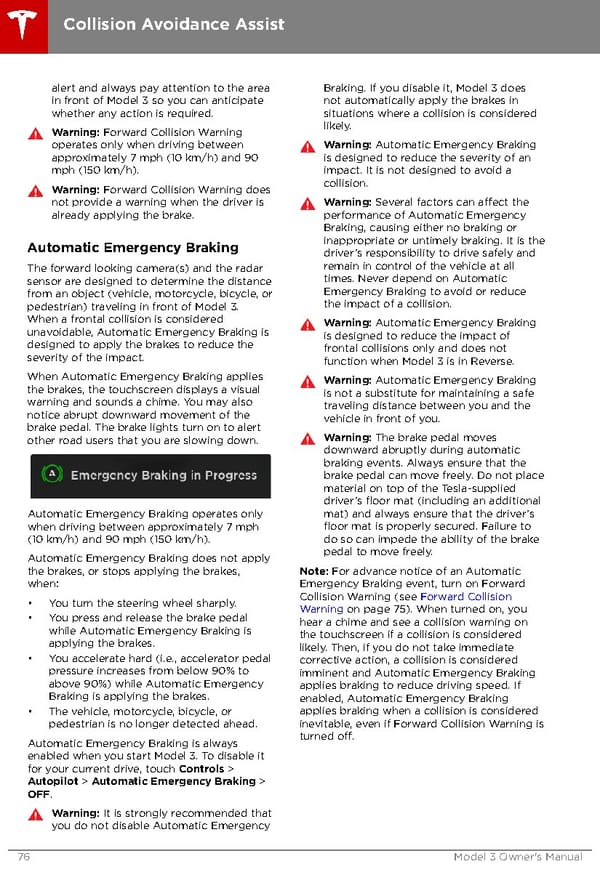Collision Avoidance Assist alert and always pay attention to the area Braking. If you disable it, Model 3 does in front of Model 3 so you can anticipate not automatically apply the brakes in whether any action is required. situations where a collision is considered Warning: Forward Collision Warning likely. operates only when driving between Warning: Automatic Emergency Braking approximately 7 mph (10 km/h) and 90 is designed to reduce the severity of an mph (150 km/h). impact. It is not designed to avoid a Warning: Forward Collision Warning does collision. not provide a warning when the driver is Warning: Several factors can affect the already applying the brake. performance of Automatic Emergency Braking, causing either no braking or Automatic Emergency Braking inappropriate or untimely braking. It is the driver†s responsibility to drive safely and The forward looking camera(s) and the radar remain in control of the vehicle at all sensor are designed to determine the distance times. Never depend on Automatic from an object (vehicle, motorcycle, bicycle, or Emergency Braking to avoid or reduce pedestrian) traveling in front of Model 3. the impact of a collision. When a frontal collision is considered Warning: Automatic Emergency Braking unavoidable, Automatic Emergency Braking is is designed to reduce the impact of designed to apply the brakes to reduce the frontal collisions only and does not severity of the impact. function when Model 3 is in Reverse. When Automatic Emergency Braking applies Warning: Automatic Emergency Braking the brakes, the touchscreen displays a visual is not a substitute for maintaining a safe warning and sounds a chime. You may also traveling distance between you and the notice abrupt downward movement of the vehicle in front of you. brake pedal. The brake lights turn on to alert Warning: The brake pedal moves other road users that you are slowing down. downward abruptly during automatic braking events. Always ensure that the brake pedal can move freely. Do not place material on top of the Tesla-supplied driver†s floor mat (including an additional Automatic Emergency Braking operates only mat) and always ensure that the driver†s when driving between approximately 7 mph floor mat is properly secured. Failure to (10 km/h) and 90 mph (150 km/h). do so can impede the ability of the brake Automatic Emergency Braking does not apply pedal to move freely. the brakes, or stops applying the brakes, Note: For advance notice of an Automatic when: Emergency Braking event, turn on Forward • You turn the steering wheel sharply. Collision Warning (see Forward Collision • You press and release the brake pedal Warning on page 75). When turned on, you while Automatic Emergency Braking is hear a chime and see a collision warning on applying the brakes. the touchscreen if a collision is considered likely. Then, if you do not take immediate • You accelerate hard (i.e., accelerator pedal corrective action, a collision is considered pressure increases from below 90% to imminent and Automatic Emergency Braking above 90%) while Automatic Emergency applies braking to reduce driving speed. If Braking is applying the brakes. enabled, Automatic Emergency Braking • The vehicle, motorcycle, bicycle, or applies braking when a collision is considered pedestrian is no longer detected ahead. inevitable, even if Forward Collision Warning is Automatic Emergency Braking is always turned off. enabled when you start Model 3. To disable it for your current drive, touch Controls > Autopilot > Automatic Emergency Braking > OFF. Warning: It is strongly recommended that you do not disable Automatic Emergency 76 Model 3 Owner's Manual
 Tesla Model 3 | Owner's Manual Page 75 Page 77
Tesla Model 3 | Owner's Manual Page 75 Page 77